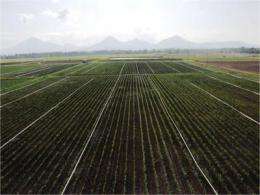Rice yields researched to tackle food security issues

A pioneering project in the Philippines, which aims to develop a new, higher-yielding rice plant which could ease the threat of hunger for the poor, is being led by an academic at the University of Sheffield.
Currently, more than a billion people worldwide live on less than a dollar a day and nearly one billion live in hunger. Over the next 50 years, the population of the world will increase by about 50 per cent and water scarcity will grow. About half of the world´s population consumes rice as a staple cereal, so boosting its productivity is crucial to achieving long-term global food security.
The project, which is being led by Professor Paul Quick from the University's Department of Animal and Plant Sciences and coordinated by the International Rice Research Institute (IRRI), is hoping to considerably boost global rice production by using modern molecular tools to produce a more efficient and higher-yielding form of rice.
The work comes as the University of Sheffield launches a unique venture entitled Project Sunshine. The project aims to unite scientists in finding ways to harness the power of the sun and tackle one of the biggest challenges facing the world today: meeting the increasing food and energy needs of the world´s population in the context of an uncertain climate and global environment change.
The researchers are addressing this issue of food security by studying the mode of photosynthesis - the process by which plants use solar energy to capture carbon dioxide and convert it into the carbohydrates required for growth - used by rice. Unlike some plants, rice has a type of photosynthesis known as C3, in which the capture of carbon dioxide is relatively inefficient. Other plants, such as maize and sorghum, have evolved a much more efficient form of photosynthesis known as C4 and their crop yields are improved by more than 50 per cent.
Using a grant of US$11 million over three years from the Bill and Melinda Gates Foundation, the team are hoping to change the biochemistry and anatomy of rice leaves to increase grain yield by introducing a C4 mode of photosynthesis. Currently, the project is in the gene discovery stage, which involves randomly mutating sorghum and rice to try and determine which genes regulate and determine C4.
Research will shortly be moving into phase two, which will involve engineering rice to allow the team to test the gene function. In addition, for the first time, natural variations in rice are being studied using IRRI's world gene bank of rice to look for natural variation. In total, the project is expected to span over a 15 year period.
As a result of research into the re-engineering of photosynthesis in rice being conducted by this group, rice plants that can produce 50 per cent more grain using less fertilizer and less water will be brought a step closer to reality. The project will also act as a model project for changing any other C3 crops, (e.g. wheat and barley), into C4.
Professor Paul Quick from the University of Sheffield's Department of Animal and Plant Sciences is heading up the team, which includes a team of 70 researchers, as well as 20 international collaborators world-wide. He will be working with Professor Richard Leegood, also from the University´s Department of Animal and Plant Sciences and Professor Peter Horton, FRS, who has collaborated with the IRRI on improving rice photosynthesis for over 15 years.
Professor Paul Quick, from the Department of Animal and Plant Sciences at the University of Sheffield, said: "C4 rice is a completely novel idea. Nowhere else in the world and never before have scientists been able to supercharge a C3 plant and convert its photosynthetic mechanism into C4. A C4 photosynthetic engine in rice would increase the efficiency of solar energy conversion by 50 per cent and nearly double its water use efficiency, as well as improving its fertilizer-use efficiency. This innovation will improve the lives of hundreds of millions of poor people and contribute to protecting the natural environment."
Professor Peter Horton, from the University's Department of Biology and Biotechnology, said: "Increasing the efficiency of photosynthesis is probably essential if we are to deliver the required increase in crop yield needed for global food security. This is high risk/high reward research, and it is tremendous to see the University playing a leading role. This is exactly the kind of exciting, ground-breaking research which we are fostering within Project Sunshine."
Provided by University of Sheffield

















